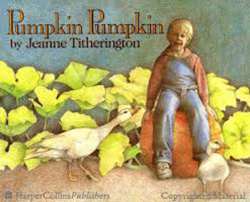
Pumpkin Pumpkin
The story's character, Jamie, plants a pumpkin seed and observes the plant's growth, blossom formation, and pumpkin growth. A good exposure at an early age to the concept of life cycle.

The story's character, Jamie, plants a pumpkin seed and observes the plant's growth, blossom formation, and pumpkin growth. A good exposure at an early age to the concept of life cycle.
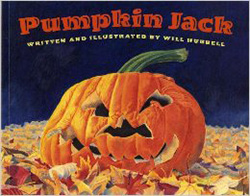
Join Jack in his voyage of discovery as he experiences death, decomposition and rebirth as his jack-o-lantern fades, rots and new plants grow from a seed left inside the pumpkin shell. That seed sprouts and the growth leads to a new crop of pumpkins.
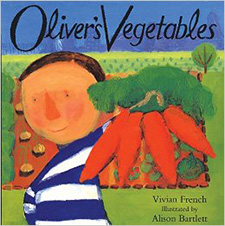
On a visit to his grandparents' house, Oliver wants to eat only French fries. Grandpa tells him that he may look in the garden for potatoes, but that he must eat what he finds, whatever it may be. On the first evening, Oliver pulls up carrots and discovers that he likes them. On successive days he discovers spinach, rhubarb, cabbage, beets, and peas. A fun book about eating from the garden.
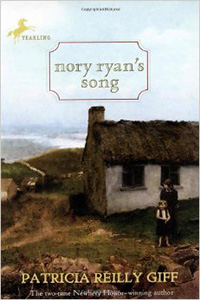
Life is hard for poor Irish potato farmers, but 12-year-old Nory Ryan and her family have always scraped by... until one morning, Nory wakes to the foul, rotting smell of diseased potatoes dying in the fields. And just like that, all their hopes for the harvest--for this year and next--are dashed. Hunger sets in quickly. The beaches are stripped of edible seaweed, the shore is emptied of fish, desperate souls even chew on grass for the nourishment. As her community falls apart, Nory scrambles to find food for her family. Meanwhile, the specter of America lurks, where, the word is, no one is ever hungry, and horses carry milk in huge cans down cobblestone streets.
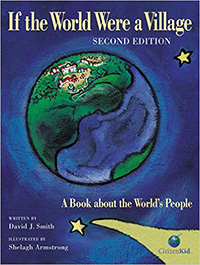
Imagine if the entire world's population were compiled into a village of 100 people. What would the demographics of that village be? This book helps students understand the similarities and differences of a global society. Comprehend the languages they speak, where they live, how much money they earn daily, and if they can read and write.
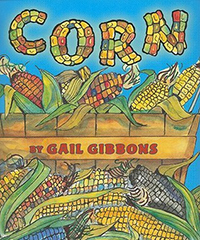
Perennial nonfiction favorite Gail Gibbons turns her spotlight on corn. Popcorn, corn on the cob, corn dogs, cornflakes - corn is used in many children's favorite foods. This book offers a cornucopia of information about the history of corn as well as details concerning planting, cultivation, harvesting, and its many uses.
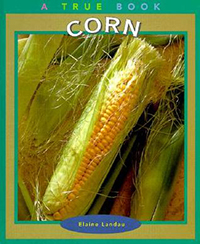
This book takes a thorough look at corn, providing high quality information in both text and image. It provides a comprehensive overview of types of corn and their uses, how and where corn grows, the history of corn, and the uses of corn for food and more. The text and photos describe how corn is used in both food and non-food items. A section on corn breeding and the use of corn in creating renewable fuels and biodegradable plastics is also included. The book ends with a useful glossary.
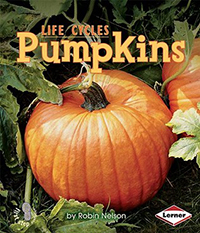
Pumpkins is a picture-book celebration of the edible plant. Full-color photography offers a tour of the life of a pumpkin plant, from planting to flower to fruit to harvest, and finally to being carved into a jack-o-lantern. Large photos and simple language make this book ideal for young students.
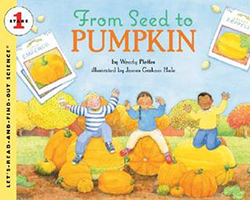
This Stage 1, Let's-Read-and-Find-Out book shows young students how a pumpkin plant grows. The text clearly presents how the plant develops from seed to mature pumpkin as well as how it obtains and distributes water and nutrients. Three children join a farmer as he plants pumpkin seeds, waters them, and observes the plants as they grow. The last two pages give instructions for two activities, "Roasted Pumpkin Seeds" and "How Plants Drink Water." This is an excellent introduction to plant development in general and pumpkins in particular.
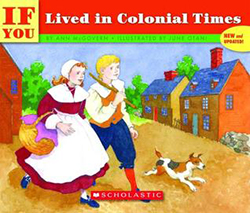
If you lived in colonial times, what kind of clothes would you wear? What would you eat? Would you go to school? What would happen if you didn't behave? This book describes what it was like to live in the New England colonies during the years 1565 to 1776, providing illustrations of how people made their own clothes and furniture and more.
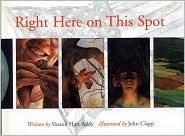
Right here on this spot, where today Grandpa drives a tractor in his cabbage field, Indians in ancient times lit their campfires, chipped stone into tools, and then moved on. Time passed, trees grew into a forest, and settlers came from across the ocean to clear the land again and make a new home. Years later, a Union soldier crossing that field lost a button. Grandpa was digging a ditch when he found that button... In graceful words and striking pictures, this book chronicles the changes the centuries bring to one field and offer young readers a vivid slice of history.
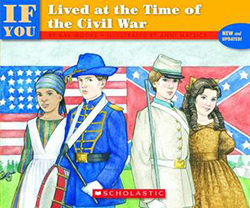
This Scholastic book illustrates what it was like to live at the time of the Civil War. Alternating pages are written from the point of view of the South and the North. Appropriate for Grades 2-6, this is a great resource to help tie lessons on cotton to social studies.